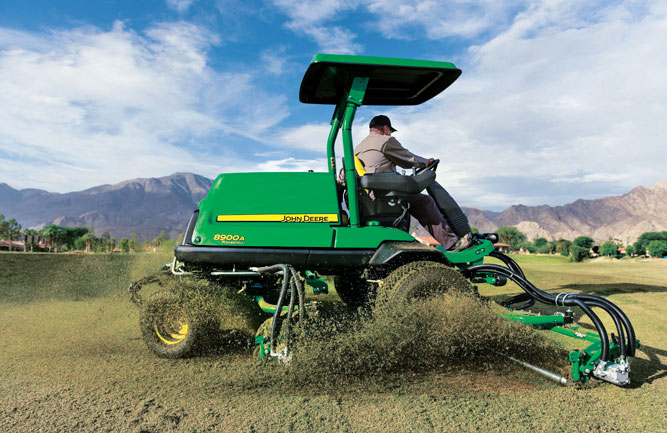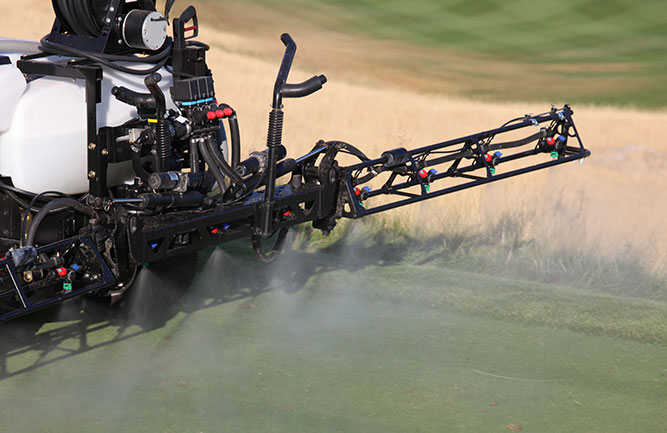Experts share why thatch control is critical to turfgrass health

Nick Christians
Although a marginal amount of thatch is acceptable on fairways — and even beneficial at times — experts say if superintendents notice more than half an inch of organic matter, it may present serious issues in the future. If fairways have excess thatch growth, most of the turfgrass’ root system may be in the thatch itself rather than in the soil.
“This results in stress on the turfgrass, which can lead to susceptibility to environmental stress and nutritional imbalances,” says Nick Christians, Ph.D., professor in the department of horticulture at Iowa State University.
Christians says aside from potential environmental stress, and nutritional imbalances, excess thatch on fairways can also trigger turfgrass disease, resulting in long-term damage.
“There’s no question about it,” he says. “By reducing excess thatch build-up — or even preventing it, preferably — superintendents will notice many short- and long-term positive effects concerning their fairways’ plant health.”

There’s a thin line between an acceptable amount of thatch and a potentially damaging amount, according to experts. (Photo: John Deere)
In addition to fairways, superintendents must also focus on greens, as they’re especially prone to thatch development. Christians says he’s seen virtually every impact thatch can have on turfgrass through his decades-long career. But, as an example of its influence on greens, some of the worst cases of Pythium blight he encounters are on greens that have an inch or more of thatch.
To help reduce the likelihood of thatch overgrowth, superintendents must implement adequate green management practices, including a program that prevents thatch accumulation.
“Avoid excess nitrogen and irrigation,” he says. “After all, thatch is generally the result of overmanagement, leading to an environment that’s ideal for overgrowth.”
Christians says reel mowers with a poor quality of cut can negatively impact fairways with excess thatch, especially those with creeping bentgrass and bermudagrass.
“Reel mowers can bounce and dig into the turf during mowing, causing a condition known as washboarding
in areas with excess thatch layers,” he says. “Up-to-date mowers with sharp blades can help minimize this condition, but, above all else, superintendents must diminish their excess thatch layers.”

John Paddock (Photo: Dryject)
Dryject
John Paddock
Owner and President
Superintendents’ inputs highly influence the rate at which thatch accumulates. They should only apply enough fertility and water to produce a uniform, healthy playing surface, as excessive inputs will magnify thatch accumulation. Superintendents can manipulate thatch levels by encouraging healthy biological activity (decay) while incorporating the native soil back into the thatch’s top portion via core aeration and dragging. Topdressing or injection with a blended soil/sand mix — or with sand alone — are other options superintendents should consider. By incorporating these materials, superintendents can create a “hybrid thatch” or mat, which firms it up and encourages robust microbial activity and decay. By regularly incorporating a desirable soil medium, superintendents will also provide a necessary dilution to this organic matter.

Paul Hollis (Photo: Redexim)
Redexim North America
Paul Hollis
Executive vice president
Excess thatch is due to beneficial microbial activity’s absence, along with improper fertilizer and topdressing applications or watering. If the layer of organic material isn’t controlled, it can affect the water and nutrient absorption into the soil profile while also impacting a fairway’s firmness and playability. Thatch control via mechanical means, such as aeration or verticutting, will help manage excess thatch. By performing these practices, superintendents will control organic matter, relieve soil compaction, stimulate root growth and improve drainage. Verticutting helps remove thatch buildup, enabling turf to effectively absorb fertilizers and nutrients. Verticutting positively impacts putting surfaces’ smoothness as it thins any tufted growth. If superintendents apply fertilizers and topdressing in a controlled manner, they’ll further increase their greens’ smoothness.

Jonathan Gladis (Photo: John Deere)
John Deere
Jonathan Gladis
System solution specialist
By maintaining a healthy layer of thatch, superintendents will notice various benefits on fairways and greens, including a decline in insect and disease pressure. Whenever there is excess thatch between the soil and the plant, pests will have an environment where they can thrive. The next benefit they’ll see is easier and more reliable moisture management. Turf plants’ roots will not only grow into the soil but also work their way into the thatch layer, which has less water available. Since thatch is hydrophobic, it can be difficult for water sources to traverse through the turf canopy and thatch prior to entering the soil. The playability of fairways and greens will increase as they’ll have more consistency, firmness and smoothness.

Cliff Stewart (Photo: STEC Equipment)
STEC Equipment
Cliff Stewart
Dealer development manager
Superintendents can alleviate excess thatch by establishing a consistent cultural practice regime of core aerification at least twice a year, followed by vertical mowing and a topdressing program. Not all clubs or budgets enable topdressing programs on fairways, so core aeration and vertical mowing are vital to minimize thatch. Turfgrass roots will become stronger, providing more consistent turf coverage. Firm and fast are the new norm for fairways, and golfers will benefit from these turf conditions. By applying the same practices to putting greens, superintendents will further improve golfers’ satisfaction. For greens, utilize additional light and frequent vertical mowing, followed by biweekly topdressing throughout the growing season. Greens’ surfaces will have firm, fast conditions, resulting in enhanced turfgrass health.












